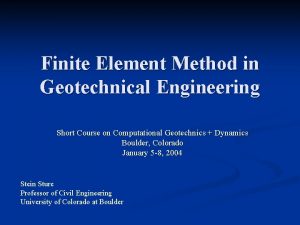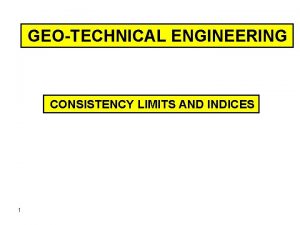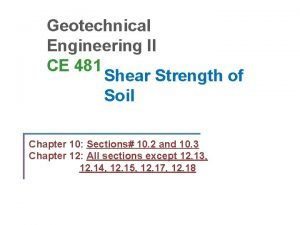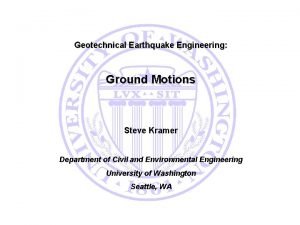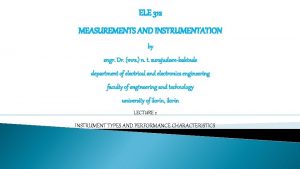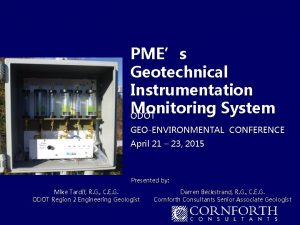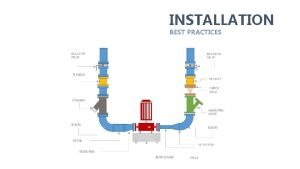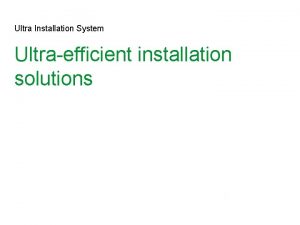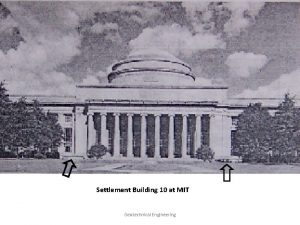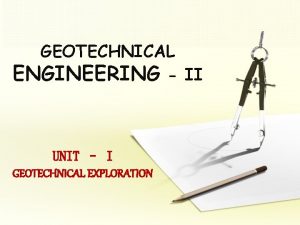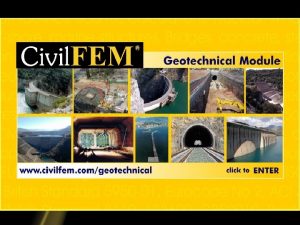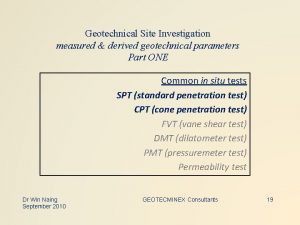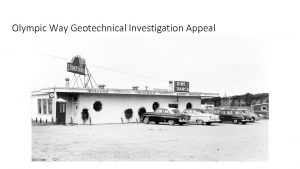GEOTECHNICAL INSTRUMENTATION INSTALLATION MONITORING GeoTechnical Instruments Geotechnical instruments














- Slides: 14

GEOTECHNICAL INSTRUMENTATION INSTALLATION & MONITORING

Geo-Technical Instruments Geo-technical instruments are used to monitor the ground and water behavior. 1. INCLINOMETER PURPOSE q The inclinometer casing is used in conjunction with inclinometer probe to monitor stability of embankments, slopes, rock cuts, foundations and excavation walls, piles. Coffer dams etc. q Underground horizontal layers movement at different depth can be identified and monitored.

Geo-Technical Instruments Geo-technical instruments are used to monitor the ground and water behavior. 1. INCLINOMETER The purpose of inclinometer monitoring is to observe and monitor any lateral movements within structures or strata and analyze whether remedial works are required to subdue any such movements. Applications for vertical inclinometers include: § Monitoring slopes and landslides to detect zones of movement and establish whether movement is constant, accelerating, or responding to remedial measures. § Monitoring secant pile, diaphragm walls and sheet piles to check that deflections are within design limits; that struts and anchors are performing as expected, and that adjacent buildings are not affected by ground movements. § Monitoring dams, dam abutments, and upstream slopes for movement during and after impoundment. § Monitoring the effects of tunneling operations to ensure that adjacent structures are not damaged by ground movements.

Geo-Technical Instruments 2. PIEZOMETER PURPOSE To measure followings: o Water pressure ( through closed type Piezometer) o Water level (through open type Piezometer) o Sudden variation of water level due to any leakage in shaft or ongoing dewatering near by construction site/zone area.

Geo-Technical Instrument s 3. Extensometer § Extensometer is specially used for Micro-Tunneling operation. § Extensometer should be installed before micro-tunneling operation. § It should be installed above center of tunnel line. § It should be 50 cm above from the top of pipe. PURPOSE To monitor followings: § over cut during micro-Tunneling operation § Internal settlement

Geo-Technical Instrument s 4. Surface Settlement Point (paved/unpaved area) The ground settlement point is used to monitor the vertical settlement on the surface of embankments, soil, masses, etc. It may also serve as a deep ground settlement point for monitoring of vertical displacement of utilities and in some cases as a benchmark. PURPOSE To monitor ground vertical settlement/road settlement around shaft and along the microtunneling line in paved or unpaved area.

Geo-Technical Instrument s 5. Convergence Point Convergence point is used inside the shaft or Diaphragm wall to monitor followings: § shaft deflection (internal /external) § Tilting of shaft

Geo-Technical Instrument s 6. Zone Station § Zone station can monitor any changes in the ground around the construction area. § Zone station shall be installed for each TBM performance. The zone station area should be 16 meter and in this area followings to be installed: § Inclinometer- 4 Nos. § Piezometer-1 No. § Extensometer- 3 Nos. § Surface settlement points- 21 Nos.

Dilapidation/ Pre-construction condition survey

Dilapidation/ Pre-construction condition survey 1. Where we conduct: The dilapidation survey is carried out on existing structures such as Building, Villa, School, Mosque, Sub-station etc. , that falls within the Zone of influence of construction activity. 2. Importance of dilapidation: The dilapidation survey is carried out to know the effect on existing structures during construction and micro-tunneling activities through installation and monitoring of dilapidation instruments.

Dilapidation/ Pre-construction condition survey 1. Crack meter/Crack guage The system consists of two plates that overlap for part of their length. One plate is calibrated in millimeters and the overlapping plate is transparent and marked with a hairline cursor. As the crack width opens or closes, one plate moves relative to the other. The relationship of the cursor to the scale represents the amount of movement occurring. These gauges are monitored over time, whilst being kept as far away from human disturbance as possible, to develop an understanding in the width and direction of movement of the crack.

Dilapidation/ Pre-construction condition survey 2. Tilt Plate/ Tilt meter Portable tilt meters are mainly used to monitor buildings, structures, utilities, etc. as well as the inclination and rotation of retaining walls, dams, piers, piles, etc. It may also be used to evaluate the performance of bridges, struts and the stability of structures in land slide areas. Tilt Plate The portable tilt meter is suitable for monitoring change in inclination of a structure. Tilt meter consists of a basic sensor housed in a rugged frame with machined surfaces that facilitate accurate positioning on the tilt plate. The bottom surface is used with horizontally mounted tilt plates and the side surfaces are used with vertically-mounted tilt plates. Tilt meter

Dilapidation/ Pre-construction condition survey 3. Building settlement point The building settlement point is to be embedded / fixed to a vertical member to monitor the vertical settlement / movement of any structure. It consists of a male anchor fitted onto the anchor socket which in place is usually embedded / fixed in a column / wall of thickness greater than 80 mm. These points are best monitored using digital level equipment for the most precise readings.

THANK YOU ASCE
 Geotechnical data management
Geotechnical data management Finite element method in geotechnical engineering
Finite element method in geotechnical engineering Applied geotechnical engineering
Applied geotechnical engineering Consistency limits in geotechnical engineering
Consistency limits in geotechnical engineering Geotechnical engineering swinburne
Geotechnical engineering swinburne Consolidated drained triaxial test example
Consolidated drained triaxial test example Geotechnical
Geotechnical Geotechnical data management
Geotechnical data management Geotechnical earthquake engineering kramer
Geotechnical earthquake engineering kramer Unsw geotechnical engineering masters
Unsw geotechnical engineering masters Pressure measuring devices
Pressure measuring devices Examples of null type instruments
Examples of null type instruments Electrical installation accessories
Electrical installation accessories Heater tube skin thermocouple
Heater tube skin thermocouple Cloud analyst download
Cloud analyst download

